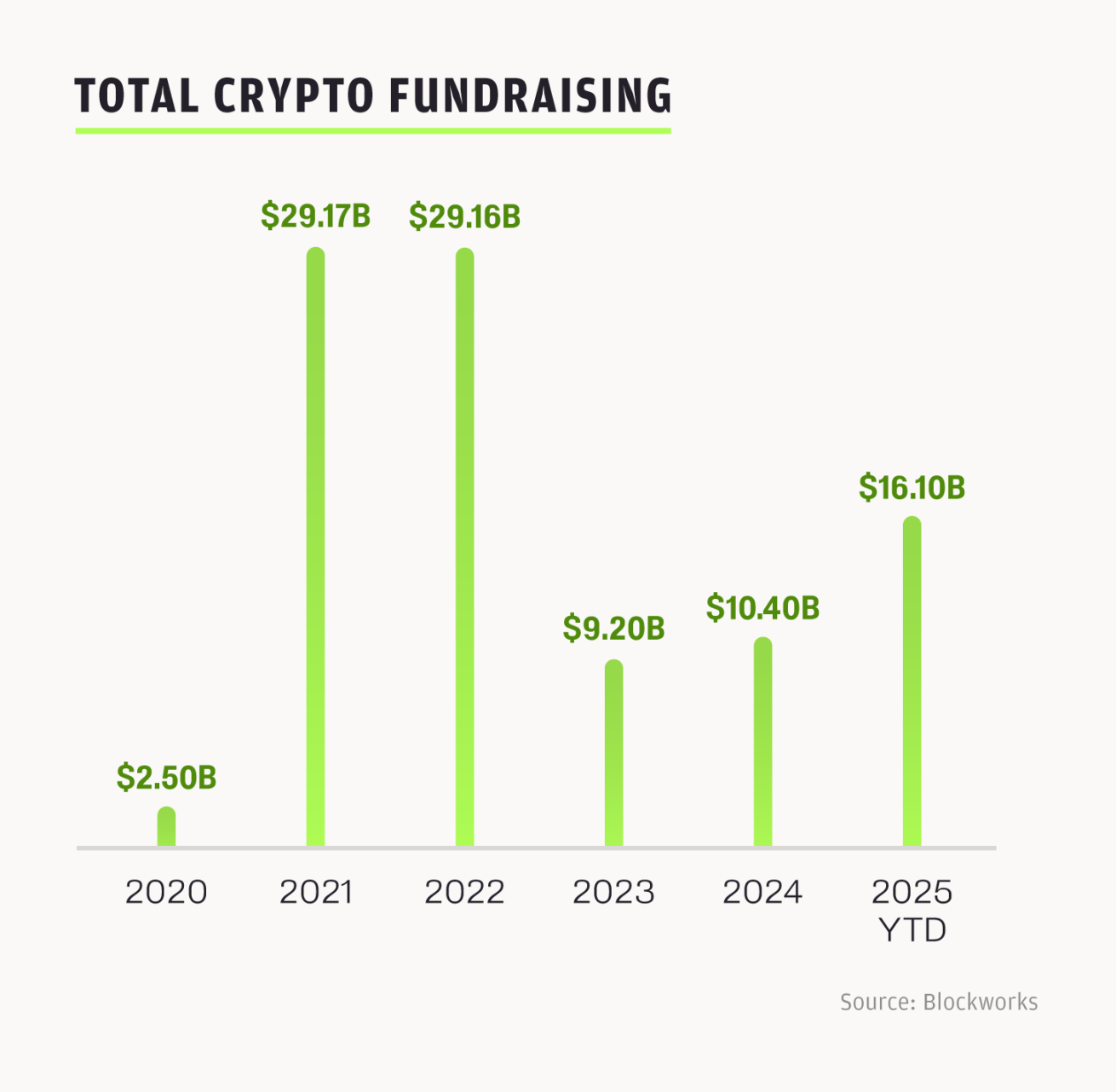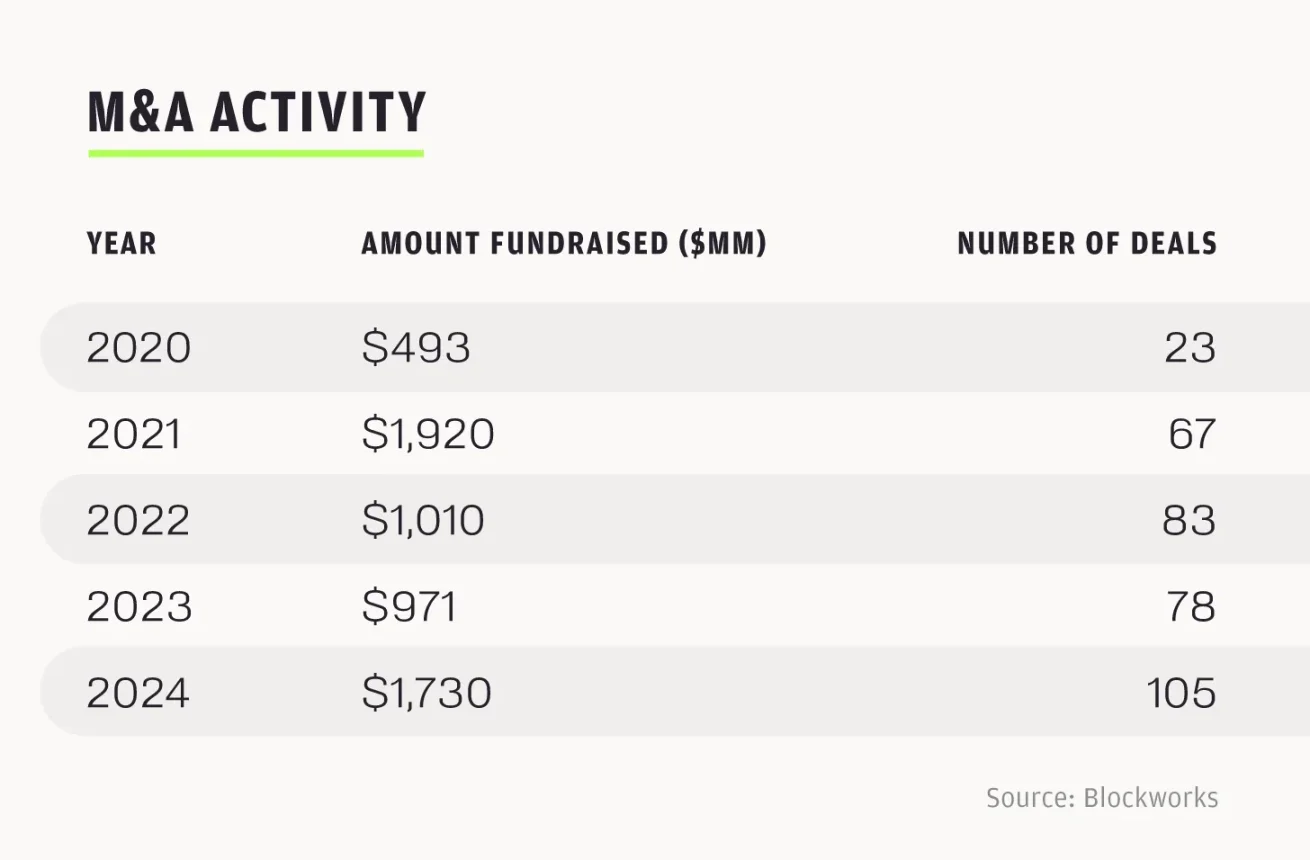Pantera Partner: Why is the 2025 Crypto VC Landscape Different from Previous Cycles?
Written by Paul Veradittakit, Partner at Pantera Capital
Compiled by: Luffy, Foresight News
Brief
Crypto-
companies have raised more than $16 billion and made more than 100 M&A deals so far this year. The industry is currently heading in a record direction, with total transactions exceeding full-year 2024 levels.
-
Driven by more transparent U.S. regulation and global growth momentum, the foundation of this cycle is more solid.
-
The wave of strategic mergers and acquisitions and IPOs will continue into the next cycle.
In 2025, record M&A and IPO activity is reshaping and driving the upgrading of the crypto industry, attracting new capital, institutions, developers, and users, and injecting impetus into blockchain innovation and applications. This pattern has also emerged in other major technological changes: decades of infrastructure construction often lead to explosive growth. The rise of artificial intelligence is due to decades of infrastructure investment, and the crypto industry is maturing much faster, relying on a more advanced technology stack to achieve compound interest with better tools. Because of this, the internal driving force of the current market is completely different from previous cycles: it is no longer dominated by speculation, but more by strategic integration.
Accelerating momentum: Why this cycle is different

The trend of the crypto market fluctuates like a sinusoidal curve. Despite the slowdown in the growth rate of the venture capital field, the industry's deep activity is actually bullish due to factors such as favorable regulation, the government's friendly attitude towards crypto, active transaction flows, increased investment in crypto business by companies such as Robinhood, and the deepening of cross-integration between crypto and adjacent fields.
After peaking in 2022, capital investment fell sharply in 2023, began to recover in 2024, and ushered in a significant acceleration in 2025: in the second quarter of 2025 alone, 31 transactions exceeded $50 million, and late-stage financing such as IPOs, mergers and acquisitions, and debt financing became the main growth force. The crypto market has attracted $16.1 billion in capital year-to-date, but crypto VCs are following the traditional VC model: capital is concentrated in a small number of funds. Capital concentration usually leads to an increase in the amount of a single investment but a decrease in the total number of transactions, which not only reflects that many crypto companies are gradually moving towards a growth period, but also means that the current funding environment is more competitive than ever, both founders and investors.
Multiple factors work together to make this cycle unique: token prices rebound, new product launches, founders have more confidence in the industry, and favorable regulations have clarified the development direction for stablecoins and digital assets, all of which have unlocked more capital for the industry. Over the years, regulatory ambiguity has created friction between innovators and the Web3 space, as all parties concern about the potential risk of penalties. The Trump administration has a friendly attitude towards the crypto industry, passing the Genius Act and the Clarity Act, laying the legislative foundation for the implementation of on-chain applications. Although we cannot be sure of the impact of these bills on the distant future, it is certain that these discussions and initiatives will reduce people's hesitation about crypto investment at the cognitive and financial level. Additionally, the Federal Reserve is expected to cut interest rates in November, which is expected to drive more capital inflows into risk assets, while the Digital Asset Trading System (DATS) will also lock capital in long-tail assets. Investors' risk aversion is gradually weakening, and the enthusiasm for capital inflows is increasing.
There has been a shift in investment allocation: one-third of capital flows are to "bottom-up" opportunities, such as perpetual contracts, token issuance platforms, prediction markets, and new DeFi basic protocols; The remaining two-thirds focus on "top-down" areas, including DATS, real-world asset tokenization (RWAs), exchange-traded funds (ETFs), and companies preparing to go public. In this cycle, public market assets dominate, making crypto assets more accessible to the wider public. This is a very healthy signal for the industry. This balance shows that the market is maturing, focusing on both innovation and integration with traditional finance.
Theblueprint for crypto legislation has a short window to develop, and the current government is supportive of the crypto industry, which will last until the 2026 midterm elections. The DeFi Education Fund is working to protect software developers: not only did it submit feedback on the Senate Banking Committee's Request for Information on the Structure of Digital Asset Markets, but it also recently released a draft discussion on the Responsible Financial Innovation Act of 2025. The 2025 Wyoming Blockchain Symposium held last week focused on digital asset regulation, emphasizing the urgency of establishing a clear crypto regulatory framework in the United States and the need to build a balanced market structure. The workshop was attended by current government officials, and the agenda included a push for forward-looking regulation. Looking ahead to the first quarter of 2026, we expect the regulatory foundation to be stronger than in previous cycles, especially in the context of time-tight times.
Token listings and IPO market restart
In 2025, the number of token listings declined, and fewer new tokens could sustain gains, dragging down downstream transaction flows. Projects that rely on token issuance will have a harder time obtaining financing if they lack market appeal.
In contrast, the IPO window has reopened. By 2025, 95 companies have been listed on U.S. exchanges, with $15.6 billion in funding as of mid-June, a 30% increase from 2024. IPOs by crypto-related companies like Circle, BitGo, and others are leading the way, giving rise to a new trend where investors are starting to allocate their money to crypto stocks rather than tokens. On June 5, 2025, Circle's listing became a key node: its issue price was $31 per share, rising to $233 by mid-July, with a return of more than 5 times and a market capitalization of $44.98 billion. Recently, Figure and Bullish also completed their IPOs, with Bullish becoming the first company to raise $1.15 billion in part through stablecoins. BitGo's plans to move forward with an IPO and have raised $100 million during the 2023 bear market highlight investor interest. Today, crypto companies are more focused on optimizing revenue and growth than pursuing speculative token offerings.
The boom in crypto IPOs and other "top-down" spaces is attracting traditional investors with robust, revenue-driven business models rather than volatile cryptocurrencies. The IPO wave is just beginning, with more to come in the coming months.
M&A activity and industry maturity
 – >
– >
2024 was a record year for M&A, with more than 100 M&A deals totaling $1.73 billion; And the number of transactions in 2025 is expected to surpass that of 2024. From January to July this year alone, 76 transactions have been completed, totaling $6.23 billion, which is 3.6 times the transaction volume for the whole year of 2024. At the current rate, there are expected to be 130 M&A transactions in 2025.
TheM&A momentum in 2025 reflects more of a signal of natural maturity in the industry than a release of pent-up demand. Strategic mergers and acquisitions, such as Robinhood's acquisition of Bitstamp, indicate that established companies are focusing on building an all-in-one platform. Robinhood is betting billions of dollars on the future of crypto, adding more credibility to the ecosystem. In the second quarter of 2025, Robinhood's crypto business revenue surged 98% year-on-year to $160 million; The company's total revenue increased 45% to $989 million and profit reached $386 million. As a stock trading platform with retail users at its core, Robinhood's embrace of blockchain infrastructure highlights the industry's shift towards mainstream and compliant infrastructure.
Similarly, late-stage financing transactions also reflect a focus on a "revenue-driven, compliant model," such as Securitize's $400 million financing from Mantle for RWA tokenization in the second quarter of 2025; Prediction market platform Kalshi raised $185 million and is valued at $2 billion. These moves show that the focus of the crypto industry has shifted to co-construction with traditional financial institutions rather than simply chasing speculative opportunities.
Cross-integration of the crypto industry with other fields
The crypto industry is no longer isolated, but is deeply integrated with today's cutting-edge technology and the global financial system.
In the field of artificial intelligence, OpenMind's OM1 + FABRIC technology stack fills the "missing layer" of the robotics industry, enabling the collaborative work of different robots in a decentralized way; Worldcoin's iris scanning authentication system relies on the blockchain identity layer, which is expected to enable AI agents to achieve autonomous authentication and transactions, solving the key problem of secure interaction between AI agents in the crypto field. Decentralized AI platforms such as Sahara AI (decentralized version of Scale AI) and Sentient (decentralized version of Hugging Face) are disrupting traditional AI infrastructure. The application layer of crypto AI is still in its infancy, but its potential may lead to a new market structure through on-chain agents and trading systems.
In the payment sector, stablecoins, particularly Circle's USDC, have become an essential part of the global payment system, and the Genius Act has further accelerated the adoption of USDC. In the first quarter of 2025, Circle's revenue grew by 58.6% to $579 million. Analysts predict that stablecoin daily trading volume is expected to reach $250 billion in the next three years; If the growth continues, it could even surpass traditional payment systems like Visa in the next decade. Companies such as PayPal and Visa are exploring stablecoin integration and integrating stablecoins into mainstream payment channels. Robinhood's partnership with Arbitrum allows Robinhood users to conduct USDC transactions directly on Arbitrum, lowering the barrier to entry for retail users to use stablecoins. This partnership is just the beginning, as Arbitrum plays a pivotal role in expanding stablecoin applications and confirms the value of Layer 2 solutions in bridging cryptocurrencies with traditional finance.
The cross-integration of these key industries brings together experts in the fields of artificial intelligence, fintech, and consumer technology, blurring industry boundaries. The crypto industry, as the infrastructure of decentralized systems, is gradually becoming a key layer in the global technology stack.
Looking ahead
,we expect the market cycle to be structurally stronger from Q4 2025 to Q1 2026. Unprecedented regulatory clarity, anticipated interest rate cuts, and significant capital inflows from strategic mergers and acquisitions and IPOs are building a solid industry foundation. The current new momentum with "real-world application value" as the core has laid the foundation for the accelerated growth of the industry. Our strategy is to seize this opportunity and focus our resources on high-certainty investments in Series A companies that are poised to define their niche and their own.
Sincethe beginning of 2025, the US IPO market has seen 224 IPOs. The number of IPOs in the first half of 2024 was 94, compared to 165 in the first half of 2025, an increase of 76%. In the first half of 2025 alone, there were 185 crypto-related M&A deals, which is expected to surpass the 248 levels for all of 2024. The successful IPOs of prominent players like Circle, along with the acquisition of crypto companies by traditional financial giants, underscore the intensity of the upcoming cycle.
The cross-integration of crypto with artificial intelligence, payments, and infrastructure, combined with favorable regulatory benefits and strong investor interest, will drive the industry into an era of accelerated growth. We will continue to strengthen the crypto industry's position as a global financial and technological pillar.
